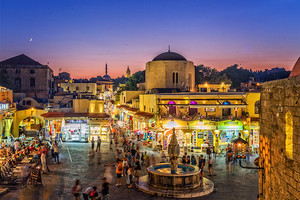
You can hear them coming, but you don’t see them until the last few seconds - and another moped buzzes past as we walk over a small stone bridge and into another maze of cobbled streets and centuries-old houses. The narrow lanes of Rhodes Old Town obviously weren’t built for automobiles, but these days they’re the perfect size for the small bikes which are the locals’ preferred mode of transport. Disconcerting at first, especially where some of the streets are just under two metres across, you soon realise the riders are adept at negotiating the pedestrians like us who are wandering aimlessly through the labyrinth of lanes, while staring up at the ancient architecture.
Surrounded by medieval walls with seven magnificent gates, entering Rhodes Old Town is a step back into more than two thousand years of history, with fantastic and well preserved monuments, squares and houses. But that’s not to say it’s one big museum - six thousand people live inside the walls and they give a real sense of life to a city which is a joy to discover. Its reputation has been built on being a sensual, sub tropical paradise, but the Greek Island of Rhodes also possesses one of the best preserved medieval cities in Europe. True there are restaurants, bars and cafés scattered throughout the Old Town, but even with a little imagination it’s not hard to imagine that this is a place that has changed little for hundreds of years.
The third largest Greek island, Rhodes is well known as a hedonists’ delight for those looking for an idyllic beach retreat, but few people realise it’s also home to the World Heritage listed medieval city, framed by its ancient harbour which was founded two and a half thousand years ago. Archaeologists believe that one of the Seven Wonders of the Ancient World - the Colossus of Rhodes - stood sentinel over the harbour and the city until an earthquake destroyed it in 226BC. The Colossus was confirmation of the fact that Rhodes was an important economic centre in the ancient world thanks to its location where the Aegean Sea meets the Mediterranean.
Like most of the Mediterranean islands, Rhodes’ history is essentially a long chronological list of conquerors and occupiers dating back to 408BC when the local islanders founded the city. Their independence came to an end in 164BC when Rhodes became a province of the Roman Empire, although its culture remained intact and it developed into one of the great centres of learning, science and the arts. From the seventh century there were periodic attacks by Muslim invaders and in 1309, Rhodes was sold to the Order of the Knights Hospitaliers of Saint John of Jerusalem - initially designed to nurse pilgrims and crusaders, the Order became a specialised fighting unit and the fortifications that now stand were built mostly during this period.
In 1522 the Ottoman Turks finally conquered the city and built mosques and public baths, in 1912 Italian troops took over, in 1948 it became a part of Greece, and in 1988 it gained a UNESCO World Heritage listing which has resulted in a lot of excavation of old ruins and restoration of existing architecture. Down at street level entering the Old Town through one of the Gates is like stepping into another world and an exploration of the city can be done in a day, although that can be a little overwhelming in a place that probably warrants three days at least.
The first thing you notice when you arrive is the formidable city walls from the 15th century which were extended and fortified by the Knights over a period of 200 years. They’re 12 metres thick with a moat that’s 21 metres wide, and it runs to around four kilometres around the Old Town. The moats themselves no longer have water in them and instead they’ve been landscaped into beautiful gardens with walking paths. Inside the city and the probably the most impressive building is the Palace of the Grand Master of the Knights of Rhodes which as built in the 14th century. Impressive on the outside, inside the enormous palace are relics from the medieval period as well as ancient sculptures and ornate first century floor mosaics.
Away from the Palace and the walls contain an endless array of bastions, battlements, towers and gates, set among imposing buildings with beautiful decorations, and paved courtyards, classic churches and imposing mosques, and museums. And set just back from this unique setting is the residential areas of the Old Town, including the Jewish Quarter, and this is where beautiful rose window gardens catch the sunlight, old men sip coffee and play backgammon in the middle of the street, and the occasional moped is the only sound to break the serene atmosphere. It’s a place that is most beautiful in the early evening when the harshness of the sun drops and casts a warm hue over the houses which date back to the Middle Ages.
Although the economy of the whole island is geared towards tourism, it is possible to experience an authentic slice of Greek cuisine and culture in some of these back streets. Many of the bars and restaurants around the major sights are geared towards foreign tourists, and their prices reflect this, but the local joints still exist and can be found just off the beaten path. It’s here that you’ll find a good Turkish coffee, selections of mezes, real moussaka, local seafood and an atmosphere that is decidedly Mediterranean - the perfect way to round off a visit to one of the truly unique cities of Europe.
- By:
- Ben Hall










